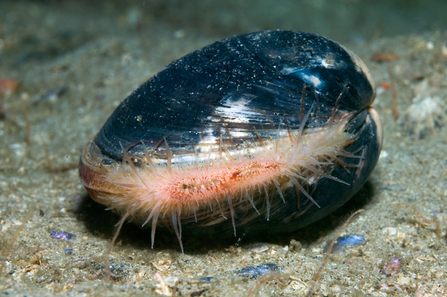Dr Emily Baxter, Senior Marine Conservation Officer, North West Wildlife Trusts, sea watching at St Bees
Battle to protect Cumbria’s seas receives a boost
Sites on the Solway Firth and West of Copeland are among the areas which will now go out to public consultation. The Government are looking for the views and support from people living in those areas to ensure that they are protected into the future.
Marine Conservation Zones or MCZs are areas at sea where wildlife is protected from damaging activities. A total of 41 special places have been chosen for the public to comment on; these range from seagrass beds in Studland Bay, Dorset to deep, rich mud habitats in the western Irish Sea.
Senior Marine Conservation Officer for the North West Wildlife Trusts, Dr Emily Baxter said: “This is encouraging news for Cumbria and a great step in the right direction. The Solway Firth site is being recommended to protect smelt, a small fish but a species of conservation importance. Smelt are also known as 'cucumber fish' due to their intense smell, reminiscent of fresh cucumbers! Smelt populations have declined dramatically over recent decades and we hope that the designation of these MCZs would help them thrive again.
“We’re delighted that protection for razorbills, an important species of seabirds, has been proposed, as an addition to the existing Cumbria Coast MCZ. This zone has been protecting 27km of our coastline, from just south of Whitehaven, around the cliffs at St Bees Head, right down to the mouth of the Ravenglass Estuary since 2013.”
“The Government’s nature conservation advisors have also recommended a new conservation site, West of Copeland, to help preserve ‘subtidal coarse sediments’. This is the coarse sand, gravel and shingle found on the seabed. Most of the marine animals that live here are found buried in the seabed – the safest place to be. They include bristleworms, sand mason worms, small shrimp-like animals, burrowing anemones, carpet shell clams and venus cockles.
“We want the people of Cumbria who cherish our Irish Sea to get involved in the consultation to protect our local wildlife. We will be launching a petition on our website over the coming days for people to pledge their support. We need to demonstrate how much people care about our coasts and seas to secure protection.”
This is encouraging news for Cumbria and a great step in the right directionSenior Marine Conservation Officer, North West Wildlife Trusts

Ocean quahog. Copyright: Paul Kay
There are also five other areas in the Irish Sea that are being considered for protection, on the Ribble Estuary and the Wyre and Lune Estuaries in Lancashire, and Queenie Corner and South Rigg in the western Irish Sea.
Emily said: “If designated, these areas would join the Fylde and West of Walney, Allonby Bay and Cumbria Coast MCZs in the Irish Sea. It will start to create a network of protection for our seas which is great news for people and wildlife. However, we are disappointed that two vital areas of deep sea mud in the Irish Sea - home to and sea pens and Dublin Bay prawns - are missing from the consultation.”
And that network is being spread right around the UK according the Director of Living Seas at The Wildlife Trusts, Joan Edwards. Joan said: “We’ve been calling for the Government to give real protection to a connected network of diverse range of undersea landscapes and species since 2009.
“Only 50 have been designated so far and this new consultation on 41 special places is really good news. We need to restore the seabed that has been ravaged over the past century and allow fragile marine life to recover – and this can only be done with good management.
“Without these astonishing undersea landscapes there simply wouldn't be any fish, let alone fantastic jewel anemones, seahorses, dolphins and all the other wild and extraordinary creatures which are part of a healthy marine ecosystem.”
The Wildlife Trusts believe that the consultation is a big step in the right direction for England’s seas. Proper protection of these sites after designation is needed through the implantation of management to give our seas a real opportunity to recover.
Joan said: “Forty-one potential new protected areas represent a great leap forward but we are disappointed that a number of sites have been left out of this process, particularly mud habitats in the Irish Sea and English Channel. Although these habitats can appear featureless, mud is a diverse and wildlife-rich habitat and we think it’s important that these areas are protected too.”
The Wildlife Trusts are calling on the public to back the 41 potential Marine Conservation Zones in the consultation – details of how to do this will be added to our MCZ page here. The consultation closes on Friday 20 July 2018.
